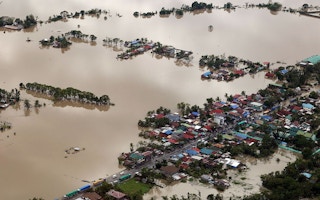The reinsurance sector is going through a difficult spell. Early this year, prices of insurance policies, typically renewed at the beginning of January each year, rose sharply against that of the previous year, as climate risks are being priced in. Industry insiders share that insurance companies, in some instances, have refrained from “providing quotes at all”, citing sky-high premiums as the main consideration.
To continue reading, subscribe to Eco‑Business.
There's something for everyone. We offer a range of subscription plans.
- Access our stories and receive our Insights Weekly newsletter with the free EB Member plan.
- Unlock unlimited access to our content and archive with EB Circle.
- Publish your content with EB Premium.
Some also call for the public sector to play a much more active role in insuring against physical climate risks, to help offset the rise in premium prices.
Brandon Bruce Sta Maria, Asean insurance leader at consulting firm Ernst & Young PLT told Eco-Business that climate change risks have critically impacted the operations of insurers and reinsurers in the region. “Reinsurers have withdrawn from previously profitable agreements due to recent events, notably the Malaysian floods at the end of 2021,” he said.
How insurance pricing issues play out over the next few years is going to be particularly important when it comes to the direction of capital and investment flows, said Christopher Au, director of the Climate and Resilience Hub, Asia Pacific at global advisory and insurance group WTW. The insurance sector plays a crucial role in supporting, and to an extent, shaping the direction of funding, such as for large infrastructure and physical projects.
“Insurance companies are saying that the [physical] climate risks are too high. They cannot charge the price that they want to because people won’t pay it,” he said.
Au believes that the public sector can step in to provide fiscal support, but also states that there might be a limit to how much the public sector balance sheet can absorb, while funding this risk.
“The fundamental question for the insurance industry will be: what will its medium-term role be in pricing in and transferring the risk, such that not all responsibilities sit with the government?”
Challenges come in the form of understanding climate-related risks and pricing them appropriately, said Sta Maria. The lack of climate risk-related tools available to understand and estimate geographical exposure, particularly for floods, has made it challenging for insurers to price risk, he said. Insurers are also struggling to estimate claims exposures when a loss event occurs.
Asia Pacific has historically been more exposed to physical climate risks, including natural catastrophes such as typhoons, earthquakes and droughts, putting its insurance industry on a different pathway compared to the United States and Europe, where natural catastrophe risks have been lower. Au told Eco-Business that Asian governments have also traditionally played a more active role in risk transfer compared to the private sector-driven insurance markets in US and Europe.
“That may actually stand them in very good stead for some of these challenges we face,” he said.
In May last year, the Thai cabinet approved a state-backed insurance programme for rice, the country’s main agricultural crop, and pledged about 1.93 billion baht (US$56 million) towards farmers affected by seven types of natural disasters, including flooding, droughts, storms, fires, and wild elephants, which frequently raid and trample on rice fields. Such initiatives, combined efforts between the public sector and the private insurance industry, could be a step forward.

A wild elephant at Khao Yai National Park in Thailand. Raids by wild elephants are among the main physical risk factors for rice crops in Thailand and the damage they cause is insured via Thailand’s government-backed rice insurance programme. Image: Kent MacElwee, CC BY-NC-ND 2.0 via Flickr
There are also promising opportunities in Southeast Asia, where the protection gap for property and casualty, as well as life insurance, remain large, said Sta Maria.
“Individuals and businesses in this part of the world have far lower levels of protection than they should have. To address this issue, insurers need to rethink their product offerings, not just by understanding current market demands but also to ensure supply is able to meet those demands,” he said. To do this, insurers will need clear knowledge of related risks, how to price them and proper management of associated costs.
Data from global ratings agency Fitch Ratings show that the prices of insurance policies, particularly for property and specialty insurance cover, have risen sharply. In a report published this year, global insurance provider Aon also described 2023’s renewal for property catastrophe insurance as “the most challenging in a generation”, citing fundamental shifts in pricing and risk appetite as a main factor.
Pressure is also coming from within the industry for insurers to integrate net-zero targets into their underwriting decisions, said a report produced by UK-based advisory firm Faber Consulting on behalf of national reinsurer Malaysia Reinsurance. Under the Net-Zero Insurance Alliance, a group of insurers representing more than 14 per cent of global premium volume have committed to transitioning their underwriting portfolios to net-zero greenhouse gas emissions by 2050.
Some of the world’s largest reinsurers have already imposed restrictions on “unconventional fossil fuels” such as tar sands and Arctic oil and gas drilling, the report said. “This will have a significant impact on the insurability of carbon-related risks, particularly for thermal coal and new oil and gas projects,” it added.
Faber’s survey of twelve Malaysian insurers found that they agreed on the importance and relevance of considering environmental factors, but wanted measurements to be clearer and taxonomies to be better defined.
They expect that this process may well take some time to finalise, the report said. “The introduction of an environmental, social and governance (ESG) rating will ultimately result in higher prices and reduced access to insurance funds for some industry players. Others, however, may benefit from lower costs and preferential funding.”








